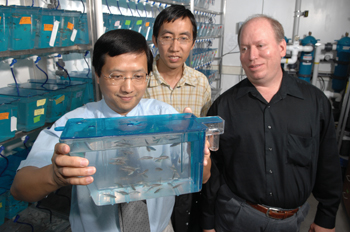
Tao Zhong, Ph.D., left, in the lab with colleagues Haibo Jia, Ph.D., center, and Sam Wells, Ph.D. (photo by Neil Brake)
‘Gridlock’ puts brakes on heart growth: study
In the developing heart, size matters.
The molecules that control how many heart cells develop, and how large each cell becomes, have been something of a mystery. Now, Tao Zhong, Ph.D., assistant professor of Medicine, Pharmacology and Cell & Developmental Biology, and colleagues have discovered a factor that regulates heart size.
The investigators reported in the Aug. 28 Proceedings of the National Academy of Sciences that a protein called “Gridlock” puts the brakes on heart growth in zebrafish. The findings shed light on how the heart grows to the appropriate size and could open new avenues for replenishing cardiac cells in failing adult hearts.
Zhong discovered the Gridlock gene — so-named because its mutation in developing zebrafish embryos disrupts formation of major blood vessels, bringing circulatory “traffic” to a standstill. The team's new studies expand Gridlock's role: in addition to participating in blood vessel development, the factor regulates embryonic heart growth.
The investigators demonstrated that zebrafish with mutations in the Gridlock gene had larger hearts with an increase in both the number and size of cardiac cells. Conversely, zebrafish with extra Gridlock activity had smaller hearts with fewer, smaller cells.
“It has long been hypothesized that cardiac cell division and cell growth are tightly coupled during heart development,” Zhong said. “We have now provided a molecular link between proliferation and growth in cell size in the developing heart.”
The research team was able to directly observe individual developing cardiac cells in live embryos using an advanced imaging technology developed in collaboration with Sam Wells, Ph.D., director of the Vanderbilt Cell Imaging Shared Resource.
The findings excite Zhong because they suggest that tapping into the Gridlock signaling pathway may offer a way to spur adult cardiac cells to divide.
Adult heart cells increase in size in an attempt to offer more pumping power to a damaged heart, but they are not able to divide. Eventually, the individual cells become too large to be effective, contributing to dilated cardiomyopathy and heart failure.
Gridlock, Zhong and colleagues discovered, partners with a molecule called Gata5 to regulate heart growth. Gata5 is like the accelerator, turning on genes that increase cell size and proliferation, while Gridlock acts like the brakes, keeping growth from getting out of control.
“This is a very elegant system that uses opposing activities to precisely control heart growth, in order to ensure the correct size of the heart during development,” Zhong said. “We think that if we can inactivate the Gridlock side of the pathway (take off the “brakes”), that may provide a therapeutic approach to turn on proliferation machinery in adult cardiac myocytes.”
Both Gridlock and Gata5 are transcription factors that turn other genes on or off. The team used microarray technology and new analysis algorithms developed by Terri Ni, Ph.D., research assistant professor of Biomedical Informatics, to discover that Gridlock and Gata5 regulate a selective group of “immediate-early growth genes,” including fos, jun and egr-1. These genes are normally turned on in hypertrophic and dilated hearts in humans.
“We believe that we now have a comprehensive understanding of the transcriptional repressor Gridlock, including its interacting partner, the downstream genes it controls, and the potential of targeting this pathway as a therapeutic approach in cardiovascular diseases,” Zhong said.
There are also interesting hints that the Gridlock/Gata pathway may be causing some human congenital heart diseases, which occur in one in 100 live births and remain the leading non-infectious cause of death in infants.
A mutation in the human equivalent of the Gata5 gene was linked to a ventricular septal defect (a hole in the membrane between heart chambers), and recent studies reported that a Gridlock mutation was associated with a human cardiac septal defect as well, Zhong said.
Zhong's team is setting up international collaborations to search for Gridlock and other developmental gene mutations in patients with cardiovascular diseases.
Other authors of the PNAS paper include Haibo Jia, Ph.D., Sameer Chopra and Haiyan Wan, Ph.D., from Vanderbilt, and Isabelle King, M.D., and Deepak Srivastava, M.D., from the University of California at San Francisco. The research was supported by the National Institutes of Health, the March of Dimes, and the American Heart Association.













